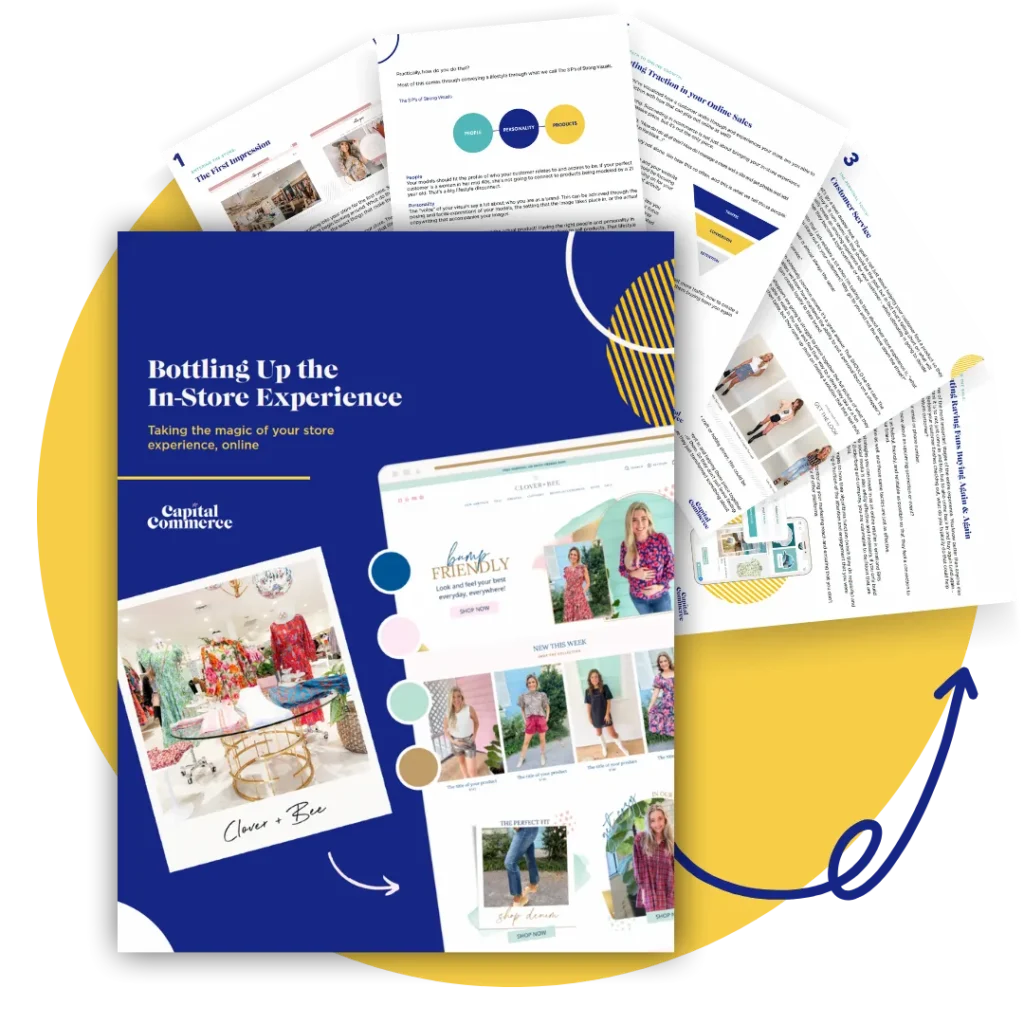If eCommerce seemed optional before, nobody thinks so now. But, how to actually succeed online is a different story.
For most brick and mortar retailers, the idea of growing their business online seemed impossible. It’s like Michael Jordan trying to play baseball. Though he’s a great athlete and was “passable” as a good player, he wasn’t operating out of his strength.
In the same way, doing in-store retail likely feels natural to you but online retail might feel more challenging.
So here is the question: How do we transfer all the skills or “secret sauce” of your store and take it online? This is the question that must be answered to come out of this stronger than ever.
We’ve been working with brick and mortar retailers in either launching or growing online for several years and though success has looked different for all of them, they’ve all overcome the same important (and easily overlooked) obstacles. If you can work your way through these, you’ll be on the path to eCommerce success.
Obstacle 1: Taking Your In-Store Experience Online
If you think about it from your customer’s point of view, you probably have a pretty incredible store. From the visuals of your store to the customer service you provide and the lifestyle, you invite your customers into…all of these things come together to create something awesome.
This is the in-store experience.
But if I asked you to describe it, what would you say?
A few months ago I was traveling and went shopping near my hotel. I discovered this incredible store that felt like it was literally created for me. As soon as I walked in, I was experiencing something that was hard to put my finger on. From the images on the wall to the store staff, merchandising, and so on, there was something elevated about the in-store experience.
Well, they didn’t have my size in something and they encouraged me to order online, so a few days later I went online to order the item and the website was…. a let down. What a bummer. All of the magical pieces of their storefront were missing. It wasn’t ugly…but it lacked everything I loved about their store.
Successful online retailers find ways to “bottle up” their in-store experience and take that same experience online. This might be by using life-style imagery and catch copy (text) in your site’s main image (called the “hero” banner) and being creative in product descriptions. It could also be through creative uses of video or other visual elements that speak to your customer.
Here are a few questions to help you get started:
- When someone walks into your store, what is the first thing they should see?
- How is your customer greeted? Is it more formal, or do you play the role of “shopping with a friend?”
- If your brand were a person, what type of voice would it have? What type of copy would communicate that online?
Obstacle 2: Understanding your customer
This might seem obvious. For brick and mortar retailers, we “see” our customers everyday so it’s easy to understand them.
If I asked you to tell me who your perfect customer was, how would you respond?
I get answers all over the place. “Women between 25-55”, “Income from 50k-250k”, and my favorite “our customer is everyone!”.
These are understandable answers but as an independent retailer, you can quickly become overbought in inventory, waste a lot of money on marketing, and miss out on a huge business growth opportunity.
You’ve probably heard the phrase, “if it’s everyone’s job then it’s no one’s job”. In this situation, it’s better worded, “If everyone is your customer, then no one is your customer”.
Here’s what I would argue: For the majority (which likely includes YOU) of independent retailers, you can only have ONE perfect customer.
That means your “perfect customer” isn’t an age range but is actually a woman named Ashley, who’s 33, a mom of 2, working full time, and so on. One of the easiest pathways to retail success is to create a single customer avatar and run every business decision through how that person would respond.
This helps in your buying strategies, store layout, who you choose for models, and just about everything else in your business.
For your customer, it creates a business that they go from thinking about neutrally to being a raving fan because they’ve found a place just for them. People want to belong to something which means when you niche down, you get to scale up.
Now some of you might be thinking, “well, there’s not enough 33 year old moms to support my business” and I will agree with you. This way of thinking is what creates the problem to begin with…we worry about who we’ll lose over focusing on who we’ll gain.
By targeting a single avatar (customer profile), you’ll still be able to gain customers outside of those demographics because of overlapping taste, influences, and style. You might market to 33 year old moms but you’ll find that you have 25 year old young professionals and 45 year old women with similar taste. You don’t necessarily lose those customers, they just shouldn’t be your focus.
Here are some questions to ask yourself when going online:
- Who is my perfect customer? Who do I want to serve? Is my customer different than me?
- What problem is my customer trying to solve and why are they trying to solve them? How am I uniquely equipped to solve that problem for them?
- Knowing more about my customer, what online places do they already visit and how can I model what those sites are doing?
Obstacle 3: Creating a good salesperson
In your store, it’s pretty easy to figure out who is good at sales and who isn’t. If you’ve been in retail any time at all, you can usually spot the good sales people from the bad. How? They obsess over their customers’ needs, they understand how to suggest things and not come off too “salesy”, all the while creating an amazing shopping experience.
With eCommerce, it’s easy to think that by simply putting products online people will buy. But the truth is, just like your in-store experience (don’t we all obsess over merchandising?) requires good salespeople, so does your online experience.
What does this actually look like?
Well, it involves a few key things:
- Experience: Your customer should have an easy shopping experience with you. Are your categories easy to follow? Does your homepage have curated content they can browse through? How many steps does it take to get to a product page, and then actually buy it? From easy-to-understand navigation to a simple checkout process, there should be few things in the way of your customer buying from you.
- Trust: With a brick and mortar store, it’s easy to establish trust. They can see you, talk to you, see and touch the product. But online, we’re looking at someone who doesn’t know you and has never been to your store. So by having a clear return policy, consistent design, and (when possible) using your own images, you’re giving the customer more assurance in your brand – which makes it easier for them to buy.
- Risk: Whenever you shop online, there is a risk involved as the customer. Whether that’s not getting the product at all (see “trust”), the product not fitting correctly, or it just not being what you expected, there is a small amount of doubt you have to overcome with buying online. By giving product details (how do you wash it, what is the fabric, etc.), sizing charts, or any other info that could be helpful in the decision process, we assure the customer that they have very little to risk in buying from you and, if they don’t love it, very clear expectations on what returns will look like.
- Sales Ability: Let’s not forget that your site needs to actually be able to sell. This means that your images, copy, and layout should make the customer want to navigate through your site. When they view a product, they need to be able to see themselves in that item and, more importantly, see how they’re better because of it.
Here are a few questions to ask:
- How would my site come across to someone who has never heard of my store?
- How easy is it to shop with me? Can people find products easily? Do they have a clear understanding of our most recent collections?
- Are we creating any surprises at checkout, or do we clearly communicate shipping and returns throughout the site?
Creating a plan
Of all the things I’d hope you take away, it’s this: online success comes down to creating a plan and executing it.
Success just won’t happen.
Whether it’s your plan to launch your site, tell your story, get people to visit your site, or how to take better photos, having a clear strategy in place is essential.
What I don’t want you to do is spend a bunch of time focusing on things that will not have a direct impact on your online success. You probably don’t have the time or money to do that.
If you think you might need some extra help, we set aside a few blocks of time each week to help retailers get a sense of direction through a free strategy session. At the end of this 30 minute call, you’ll have a clear idea of what is needed for your business to succeed online.
These can apply for a free strategy session HERE.
Whatever your next steps are, we hope that you can overcome these obstacles and that you come out of all of this stronger than ever.




